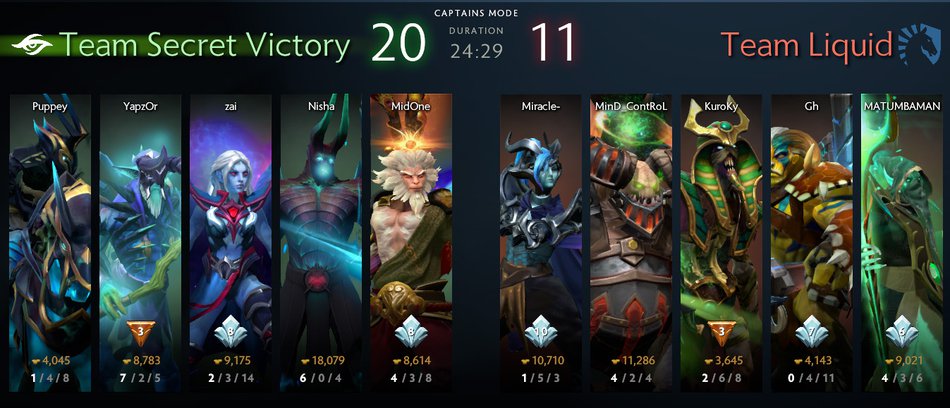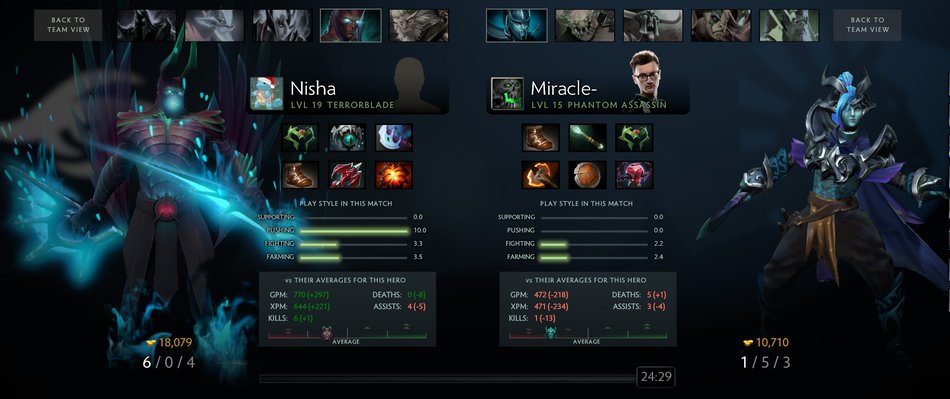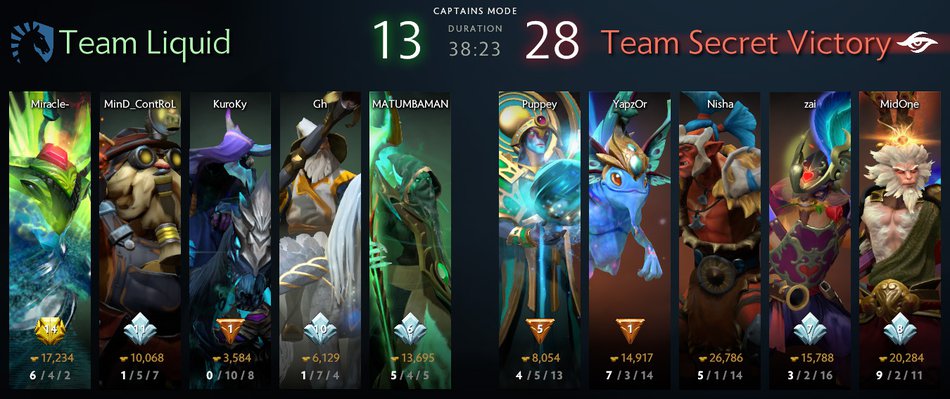- English
- Русский
Stockholm Major, DramLeague Season 11, Group Stage
At
the beginning of competitive Dota, there
was a very big gap between T1 and T2/3 teams. In the west there was Na’Vi and
then there was everyone else. Then steadily but surely the overall skill level
in the competitive scene improved and first Alliance, but then many other teams
after them reached the T1 level.
Right now, however, for some reason, the gap between the T1 and T2/3 teams seems to be getting bigger once again. Teams like Secret, VP, and Liquid look untouchable and are consistently able to top tournaments, in a similar way to Alliance and Na’Vi back in the days.
This is what made this first series between Secret and Liquid very significant. It’s a flashback to El Clásico. How they play the game (especially Secret) will define the current meta not only in this tournament and the pro scene but maybe also in pubs.
Because of this, it makes sense to study this clash of giants closely and see what we can learn from it!


When you look at Liquid’s lineup, you certainly don’t think about weak lanes. Yet, on the 12th minute, they were at a 6k gold deficit. This is terrible news for their lineup which is most definitely not built to play from behind – they want to be ahead in order to hit their early-mid game 5-man Dota timing with their extremely hard to kill Undying, Necro, and Underlord.
The way Liquid’s heroes win lanes, however, is much different than the way e.g. Lesh and Venge win lanes.
Undying, Necro, and ET don’t have huge kill potential. They are simply very durable and great at harassing. They stay in lane, whittle down their opponents and slowly but surely take control of their lane and get more farm.
In recent patches, however, denying was nerfed. This might mean that in the early game hero kills are more valuable than they were before. In other words, kill lanes are more valuable than hard-to-deal-with lanes. This is one of the reasons why Ursa, for example, is having a resurgence in popularity despite not receiving significant buffs.
In this game, the top lane (where Miracle was supposed to find farm) was heavily pressured by the kill potential of Venge + Lesh. Secret managed to secure a couple of kills and the situation became even more difficult when MidOne started rotating and fighting around the map.
The result was that Miracle had a very hard game and was almost constantly pressured, while Nisha was free farming:

The way Secret used the map to get the most
resources possible while also pressuring Liquid was very impressive. Once MidOne gets his levels he makes a couple
of rotations and then moves bot against Underlord – Secret knows he can easily
kick MindControl out of lane. In the meantime,
Nisha starts farming the jungle and Yapzor
moves to the empty mid lane. Consequently, four of Secret’s heroes finish the
laning stage with more farm than all of Liquid, which pretty much secures them
the game.

A
very interesting detail in game two was that Liquid decided to draft Necro for Matu
a second time versus MidOne’s MK. In game one, Matu lost the lane heavily – at one
point he had 9 creep kills versus MidOne’s 25, and MidOne was lvl6 when Matu
was lvl4.

Above: Matu’s face after the laning stage of Game 1
Despite this, Liquid had the confidence to send him in the same matchup for a second time, and Matu managed to deliver – the lane was much more even and Liquid’s Necrophos had a much better start. Ultimately, however, this didn’t make a big difference.
From the draft of both games, we can notice one other very interesting things - both teams had a different strategy for their win condition hero, the hard carry:
Liquid drafted the same type of lineup both games. They had one hard carry on Miracle and 4 strong 5-man Dota heroes with a strong mid game timing.
This strategy (early-mid game 5-man aggression and pushing) used to be the standard before the Midas meta. Right now, however, getting quick 20 minute victories with such a draft might be a bit harder because of the buffs to towers. Moreover, such a draft requires you to win your lanes, and with the focus moved towards kills, it’s hard to win your lanes and snowball with a draft that has little to no catch, i.e. ganking potential.
In game two, when Liquid tried to smoke up to find a kill after the lanes the lack of catch on their lineup became apparent. They needed to use big ultimates or unreliable disables to stick to a target to find kills. Their draft was made to pressure towers, and they couldn’t do this when they are playing from behind, which put them in a huge tactical disadvantage.
Secret also made sure Nisha has a hard carry, but they drafted other heroes who can scale into the late game usually on MidOne and even Yapzor, for whom they secured farm. This is a bit less risky in case Nisha has a bad game and gets countered directly (which didn’t happen in this series).
Moreover, they created space for their carry more actively. They didn’t rely so much on hard-to-deal-with lanes and 5-man dota. They used their kill potential to pressure and farm different sides of the map.
Last but not least, they always had heroes with saving mechanics on the team – Venge, Abaddon, Oracle. This made it even more difficult for Liquid to find pick-offs or to focus down an important target in fights. When Nisha was done farming and hit his timing, with the defensive supports behind him he was easily able to break the enemy base and secure the victory.
Team Liquid is without a doubt T1. Even if they aren’t trendsetters in the meta, they are usually able to win games on the back of their amazing mechanical skill. In this series, however, they didn’t seem to have a chance against Secret. This could be useful for betting in two ways.
First, it might be safe to assume Secret will make it all the way and even win the tournament. EG, LGD, and VP seem much shakier than them.
Second, teams who are able to emulate their strategies might also pull-off an upset victory.
Thanks
for reading! If you found this piece interesting, make sure to follow our social media (below) to get notified when we post something new!